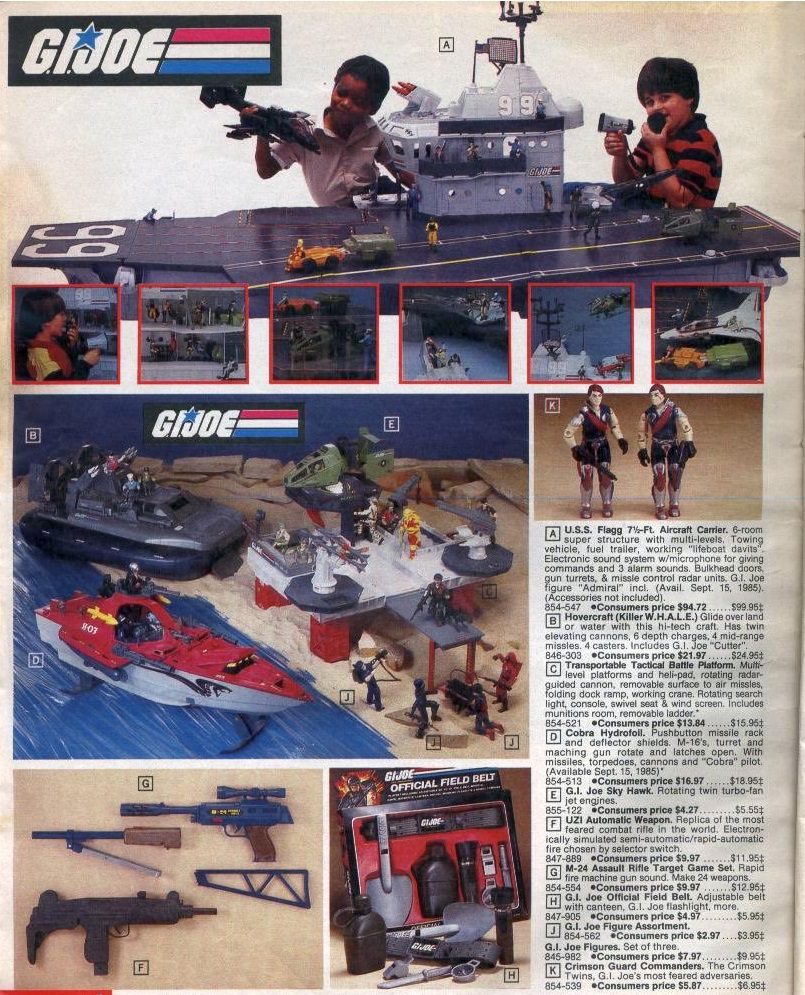Those of my vintage will know what it was like.
The process.
The anticipation.
The euphoria.
Those little golf pencils they had en masse and how they made you want to print each letter or digit in the prescribed checkboxes in your neatest possible writing.
It was the late-1980’s and there was a store called Consumers Distributing, which we kids simply called “consumers” for short.
“Wanna go to consumers?” you’d ask a friend, and you didn’t need to say anything more than that. We all knew what it meant.
It was a different kind of department store entirely.
Those of a previous vintage to mine will regale us with tales of the “Sears Catalogue,” which I do remember as well, but that didn’t hold a candle to the Consumers Distributing catalogue.
The “catalogue” in general is probably something those under thirty-years-old aren’t familiar with, but in my mind, I can still remember how it smelled.
Yes, how it smelled.
Pretend for one single second like you didn’t smell the Consumers or Sears catalogue when you took it out of the cellophane package after finding it on your doorstep one glorious fall day, after school, when you were the first one home.
Who remembers this edition?

Well, I most certainly do!
And in case it’s not obvious already, I would love to hear from anybody who shares the same passion for nostalgia and yesteryear as I do…
Consumers Distributing was an entirely different kind of department store.
Picture walking through Simpsons in the 1980’s, or even earlier for those of you that are older.
Eatons is another, or The Bay, which amazingly still exists.
A classic “department store” where the goods are displayed for all to see, touch, and feel.
What’s amazing about the evolution of department stores is that they eventually came full circle, with Consumers Distributing.
“Mail order catalogs” were around in the late-1800’s:

That is how people used to shop, in lieu of going into a store and seeing, touching, and feeling the goods.
Eventually, we did move toward department stores like Eatons, Simpsons, and The Bay here in Canada, or Macy’s or Sears in The United States.
But in the late-1980’s here in Canada, we seemed to take a step backwards and revert to a catalogue that simply listed or pictured goods, but which you couldn’t see in person at the store.
That was Consumers Distributing, for those that remember.
You were given a catalog that displayed thousands of goods, and each product had an accompanying product number.
The store itself was nothing more than a warehouse with a pretty waiting area out front.
You’d walk inside, take out a small golf pencil and an order form, jot down the product number, then hand it to a person standing at a counter.
And wait.
As Tom Petty said, “The waiting is the hardest part.”
But there was something about the waiting that simply added to the allure. Then having your name called? Oh, that was something.
Imagine a 1988-version of David, filling out his order form for one of these fine G.I. Joe products:

Okay, fine. That’s the 1985 Consumers Catalog and I was 5-years-old back then.
Forgive me, I couldn’t find the 1989 version.
But 1989 was when I was 9-years-old, and every Friday when my friend Jeff received his $5.00 allowance, we would head down to Consumers Distributing in Sunnybrook Plaza and buy a G.I. Joe man.
854-539
That’s the code for the Crimson Guard Commanders, only $5.87, which was lower, as you can see above, than the posted $6.95 price that other department stores sold the toys for.
That was the Consumers Distributing difference!
By not having a typical department store, full of displays and staff, and by simply having a warehouse of goods, each accessible by a product number, they could offer a lower price!
Jeff and I were there every Friday, like clockwork.
We would fill out our little paper slip with the golf pencil, hand our order form to a lady at the counter, then wait.
There was a little window and counter where you could catch a glimpse of what was going on in the warehouse “in the back,” and we would anxiously stare at the counter, waiting for our chosen toy to appear.
We’d watch as an employee “from the back” would walk up, but dammit – he slid a set of bed-sheets onto the counter.
“Judy?” the woman at the counter would call out, as she picked up the order form, read the name, and waited for the consumer to appear to collect her goods and pay for it.
Then another product would be placed on the counter, in the window, by a mysterious set of hands “from the back,” and while it was small enough to potentially be a G.I. Joe man, the person at the counter would collect the order form and call out “Bradley?” and crush our dreams.
Bradley. Here at Consumers Distributing to order a clock radio.
Oh, get on with it!
Where’s our G.I. Joe man?
Just when we thought we couldn’t take it any longer, a couple of small packages would slide across the counter.
“David?” the lady would call out, which, I swear, felt better than having your name called at the Ministry of Transport after a three-hour wait.
Then a little 9-year-old boy walks up to the counter, pulls out his wallet that was a product of the Blue Jays “giveaway day” and had a fat CIBC log on the front, tear open the velcro, and produce a five-dollar bill and a loonie to pay for Mainframe, Destro, Zartan, or whoever was the action figure purchased that Friday after school.
Sunnybrook Plaza at the corner of Bayview & Eglinton holds a special place in my heart.
Consumers Distributing was just one of the places we frequented as kids.
Mac’s Milk was another. It was larger and better than any of your neighbourhood “convenience stores.”
Radio Shack was so ahead of its time. Way before any big-box stores like Future Shop or Best Buyer were even thought of, let alone invented.
Home Hardware is as Canadian as poutine, and it too came long before Home Depot or Rona.
Blacks Photography was a regular part of our lives. Our mother would have the three kids wait in the car while she went in to get her “developed photos,” then we’d flip through them and see how many of the twenty-four in a roll of film had actually turned out. Yeah, for all you kids that take thirty photos of yourself on your iPhone to find one shot for your online dating profile or Instagram page, you’ll never know what it was like to shoot a full roll of film and then get them processed or “developed,” only to find that four are blurry, two are underexposed, three are completely cut off, and maybe, just maybe, half of the roll from your trip to Mexico are album-worthy.
Of course, my barber, Leo, had a shop above the ground-level stores, accessible by a small door on Eglinton Avenue. I think I visited him there once a month for over two decades…
I have written about Sunnybrook Plaza many times on Toronto Realty Blog over the years.
In fact, having started the blog in June of 2007, I actually wrote about Sunnybrook Plaza within the first year!
March 20th, 2008: Preserve History….or Build New Memories?”
Geez.
Remember a time when blog posts were only 950 words?
But more importantly, this was now fifteen years ago, and Sunnybrook Plaza has yet to be developed.
Fifteen years is a long time. You could almost build an LRT in that amount of time! 🙂
Twelve years later, I filmed a video at the site.
November 30th, 2020: What Will Become Of Sunnybrook Plaza?
And still, three years later, the site looks exactly the same.
It’s nothing but boarded-up buildings behind a chain-fence.
It’s a blight. And an eysore. And a shame. But it’s also a means to an end as far as the future of new housing construction in Toronto goes…
Last month, I came across this article in the Toronto Star and bookmarked it for discussion:
“Developers Are Turning 14 GTA Malls Into Tiny Cities, With Cloverdale Leading The Way – Is This The Solution To Toronto’s Housing Crisis?”
Toronto Star
July 8th, 2023
The headline is thought-provoking but somewhat silly.
No, this isn’t the “solution” to the housing crisis, but anything that helps build housing is part of an attempt at a “solution.”
The article didn’t come across as either for or against the idea of repurposing and redeveloping malls for housing, but rather it provided some insight into where, why, and how some of the largest developments, and new “communities,” will appear in the near future.
The intro to the article plays on nostalgia, of course:
For more than 60 years, a beige and brown — and bland, by today’s standards — one-storey shopping centre has stood nestled at the corner of Highway 427 and Dundas Street West in Etobicoke. Set on 32 acres, the mall hosts flagship tenants like Winners, an abundance of mom-and-pop shops and a food court.
Cloverdale Mall has served the surrounding community well — but it won’t be around much longer, not in its current form, anyway.
But the point is made very quickly as we get a look into the sheer number of sites that will be redeveloped in the near future:
Cloverdale is just one of 14 GTA malls developers are planning to turn into mini villages. In Brampton, Mississauga and Toronto, close to 200 residential buildings are proposed around Bramalea City Centre, Centerpoint Mall, Dufferin Mall, Fairview Mall, Scarborough Town Centre, Sherway Gardens, Square One, Yorkdale, Agincourt Mall, Atrium on Bay, Dixie Outlet Mall, Malvern Town Centre and Galleria Shopping Centre beginning in the next decade.
Opponents of the idea might suggest that building ten condos in a small, dense area is a poor idea.
A quick look at the comments section of the article shows that people hate it.
But is this a bad idea?
Developers take advantage of the key infrastructure, such as highways and transit connections like the GO, to create a “complete neighbourhood,” where grocery stores, pharmacies, community centres, parks and restaurants are erected to service the new residents.
Building near infrastructure is good planning.
As much as I’m nostalgic about Sunnybrook Plaza, that site sits directly on top of the new Eglinton LRT stop. It’s exactly where you want new housing.
Trust the words coming out of a developer’s mouth, if you dare, but the folks in the article are saying the right things:
It’s a fully functioning city ecosystem that prioritizes walkability, bikeability, green space and quick access to neighbourhood necessities, said Aaron Knight, vice-president of development at QuadReal Property Group, which will oversee the mall’s development.
“It’s around 30 acres of land, so where do you start?” Knight said. “We began by thinking about creating biking networks and lots of canopy coverage of trees on the streets, as well as multiple parks, to create public space that is fully accessible.”
The problem, as I see it, exists at the municipal level.
The sheer amount of “red tape” that exists should come as no surprise:
“Unlike a single building site, which is fairly straightforward,” said Knight, “with projects like these where you are building roads, services, sewage systems, public space and transit hubs, it takes many years of review due to the highly technical nature of the development.”
The zoning application for Cloverdale, already underway, will take around three to five years for the city to approve.
Now, I’m not saying that it doesn’t take time to build supporting infrastructure such as roads, sewage, utilities, etc.
But the idea that it could take five years for approval is disheartening.
Lots of planning goes into this, no doubt about it. But there must be a better way to get housing like this built. Despite local residents (living in detached houses…) objecting to a massive redevelopment like this, it’s truly what the GTA needs. And while I’m sure the municipalities are attempting to play fair and ensure the same attention is paid to every application, there must be a way to fast-track projects that can add tens of thousands of new units of housing.
Read the full article if you get the chance, it’s a solid piece.
Some two-hundred buildings are planned, and if we consider that the average number of units per building would be around 500, then that’s 100,000 new units of housing on the way.
Many people might ask, “Why build there?” As in, “Why do we need to tear down malls to build housing; why can’t we build elsewhere?”
Well, because most malls sit on prime land and most have existing infrastructure.
And because this is Toronto, which is way too small for the existing population, not to mention the future population.
It’s not like areas in the United States where “ghost malls” run rampant.
Try Googling “ghost malls” just for fun and it’s amazing what you’ll find.
For those interested, here’s a really cool video shot in Wisconsin where two guys explore the Northridge Mall, which has been abandoned for over a decade:
Well, I guess if we’re looking for someone or something to blame, it would be Amazon?
But we would never stop using it. Because we can’t.
Topic for another day… 🙂
































hoob
at 9:13 am
Uh, David, check your anglo privilege, Rona is much older and more Poutine-esquely Canadian than Home Hardware. tbnk.
Francesca
at 9:15 am
David, I too remember getting the consumer distributer catalogue! I used to circle all the gifts I wanted for Christmas and my birthday and then pass it over to my mom and hope most of the gifts would be bought! There’s something nostalgic in general about flipping through any kind or magazine that younger generations just can’t understand or appreciate.
As for the mall redevelopment I believe Promenade in Thornhill is now undergoing a major transformation as most of the shops are now gone. I cannot believe centre point is still standing with the Yonge subway line extension confirmed it should be under construction soon with new condos I’m sure. I was at the Shops at don mills last week and was struck by how many empty store fronts there are now. The concept of the outdoor mall isn’t the most logical for a city like ours where half the year it’s too cold to be outside! I wonder if this mall will eventually be demolished despite being less than 20 years old for more condos seeing how there are already several in its perimeter.
Nick
at 10:31 am
I think it could work but not how Shops was done. They condos encircle the complex. They should be on top of the shops and restaurants with a couple of office/medical buildings mixed in.
They are still better that the giant sprawl that is Durham Centre in Ajax.
RPG
at 9:47 am
David, I don’t mind the long nostalgic stories. I played with GI Joe too but mine were the 12-inch variety from the 60s and 70s. They were basically dolls for boys. They came with actual clothing which would always get dirty or rip if you played with them in the water or sand. Not like the smaller hard plastic action figures from the 80s which were durable. Who would have thought that a small army man doll would end up with such a cult classic following.
Nick
at 10:28 am
I’m all for these mall developments. When I was under 10 we lived in Malvern and that mall was amazing! We rarely needed to go to STC.
I drive through now and its a shell. That said the designs that have come out and the timelines are really unimpressive.
Also, my first and second bikes were from Consumers! Total chaos the day we got them!
Laurie
at 10:29 am
Oh, for me it was Sears’ Christmas Wish Book. I would circle all my wish list items and leave it strategically around the house hoping at least some would show up under the tree…
Marina
at 10:57 am
My kids still do that! We get the Indigo and Mastermind flyer books and they diligently circle what they want. I then pass it to the grandparents :). Getting the Indigo Holiday Guide is the official start of the season.
EastYorker
at 11:12 am
Still remember getting a battery every month at Gerrard Squares Radio Shack.
Ace Goodheart
at 2:19 pm
What has happened is that retail is for rich folks, and amazon is for everyone else.
If you want to shop in an indoor mall now, you have to be loaded.
Otherwise, it’s online for you. Even the restaurants are over priced.
Sirgruper
at 12:33 am
Got my 4 and 6 irons (Spalding Kroflite if I recall) from Consumers on Roselawn. Great store. A bit like the original LCBO that you ordered by catalog but with a pen attached to a beaded metal string and your box of bottles came down the rollers. Used to go with my Dad. You paid by cash and the coin change rolled down a slot and that was sometimes for me if not too much.
Losing Centerpoint (Town and Country in the old days) and the Promenade are no great losses. Yorkdale will evolve as will any better mall.
Izzy Bedibida
at 3:37 pm
I remember the local CDs. So many times, the item listed in the catalog was not exactly what was given when it was presented. Left many items behind and clerk apologizing when item dis not match pictures.
J
at 10:13 pm
I recently bought a 1995 Consumers Distributing catalog off eBay for the nostalgic value (paid more than what I’d care to admit for what amounts to a piece of junk mail).